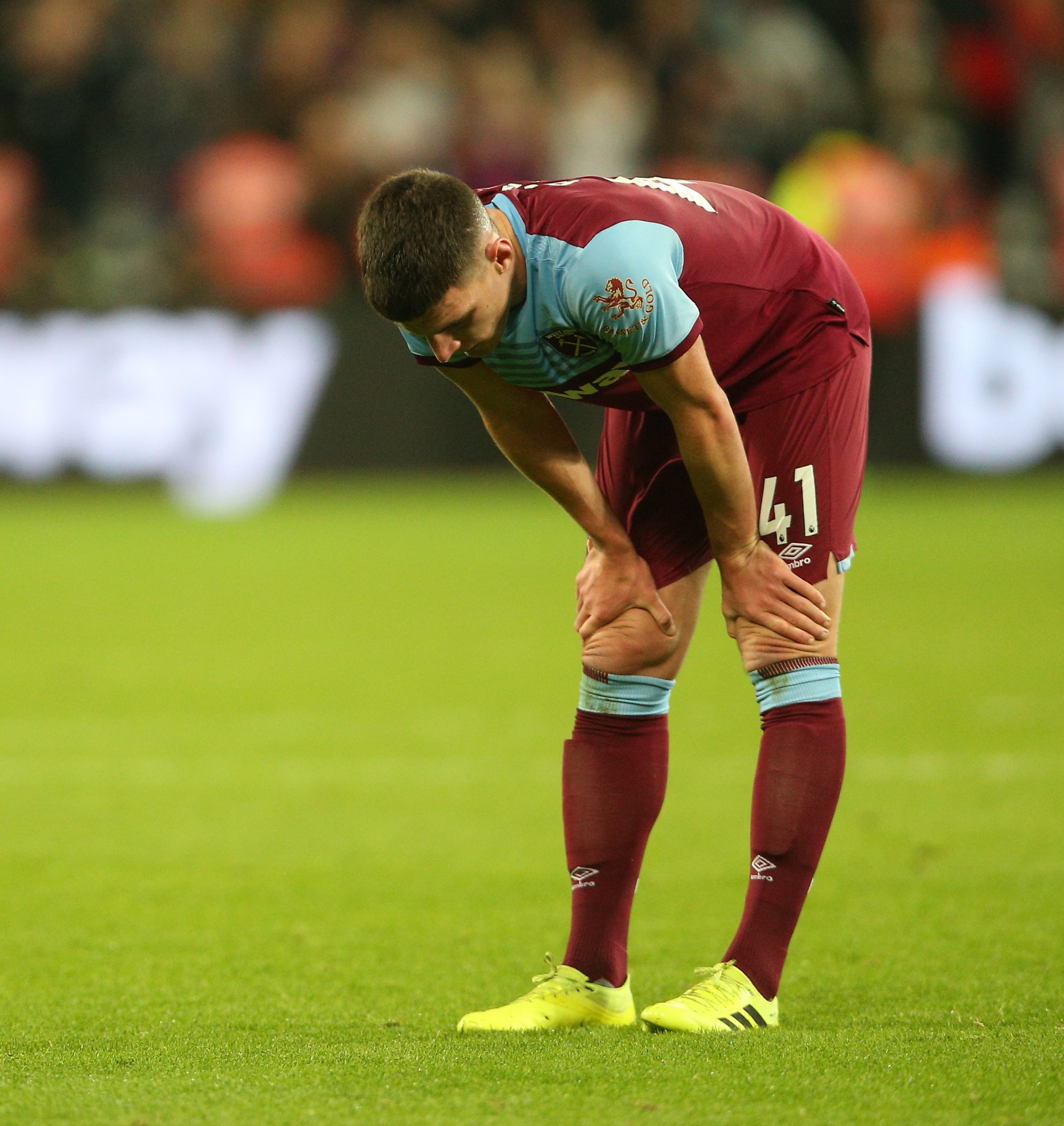Before the start of the season, many had West Ham in the upper tier of midtable sides that could potentially break the top six hegemony. It didn’t seem like an unreasonable suggestion. While Manuel Pellegrini’s side had finished tenth the previous season, this was on the same number of points as fellow “best of the rest” hopefuls Leicester and only two behind Everton. And the Hammers had signed some interesting players. Sébastien Haller had all the attributes one would look for in a striker to lead the line, while Pablo Fornals was one of the more interesting attacking midfielders in La Liga last season. There were real questions in the midfield and defence, but still, this was an interesting set of talent under a manager with a strong track record. There were, however, reasons to doubt this project. West Ham’s metrics did not look especially exciting. Their 44.62 expected goals last season was around midtable, while their 56.51 xG conceded was third worst in the league. It took a miracle of a season from Łukasz Fabiański to keep things relatively secure. StatsBomb’s shot stopping model estimates that he saved West Ham a fairly astonishing 13.75 goals against the average ‘keeper. It’s the kind of miracle that does not typically happen twice.  West Ham certainly added firepower to the attack this summer, but did almost nothing to the defensive side. With a 32 year old Mark Noble still expected to play serious minutes in midfield, it looked like there was going to be real space for teams to attack the Hammers. The optimistic case for West Ham was that they could hold things together, with Declan Rice maturing into a more dominant defensive midfielder, just enough for the potentially very exciting attack to blow sides in the bottom half of the table away. The more pessimistic view was that they’d concede so frequently that the attack would have to be amazing, and anything less would be a disaster. As it is, the attack remains middling, with their 1.24 xG for only the tenth best in the top flight. Haller has settled into life at the London Stadium quickly, getting 35% of the side’s xG himself, but Fornals has not yet got going and production doesn’t look hugely different from last season.
West Ham certainly added firepower to the attack this summer, but did almost nothing to the defensive side. With a 32 year old Mark Noble still expected to play serious minutes in midfield, it looked like there was going to be real space for teams to attack the Hammers. The optimistic case for West Ham was that they could hold things together, with Declan Rice maturing into a more dominant defensive midfielder, just enough for the potentially very exciting attack to blow sides in the bottom half of the table away. The more pessimistic view was that they’d concede so frequently that the attack would have to be amazing, and anything less would be a disaster. As it is, the attack remains middling, with their 1.24 xG for only the tenth best in the top flight. Haller has settled into life at the London Stadium quickly, getting 35% of the side’s xG himself, but Fornals has not yet got going and production doesn’t look hugely different from last season. 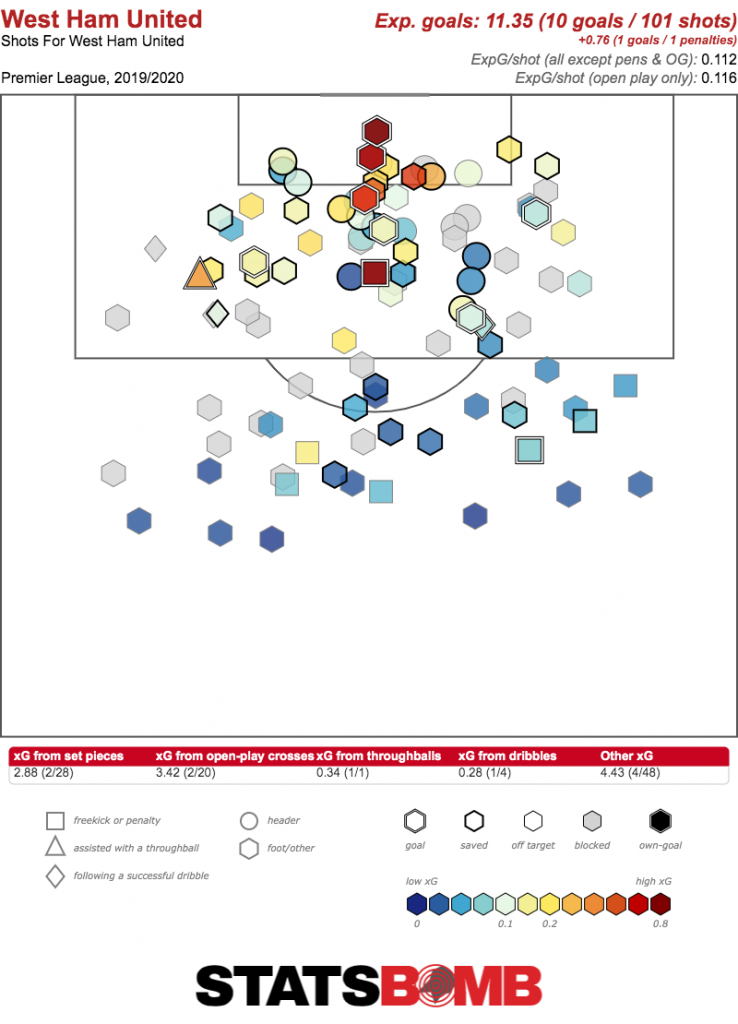 But it’s the defence where things get dicey. The xG isn’t just bad. Bad would be tolerable at this point. It’s worst-in-the-league bad. The opposition haven’t found the back of the net as frequently as the chances would suggest, but West Ham are certainly being carved open.
But it’s the defence where things get dicey. The xG isn’t just bad. Bad would be tolerable at this point. It’s worst-in-the-league bad. The opposition haven’t found the back of the net as frequently as the chances would suggest, but West Ham are certainly being carved open. 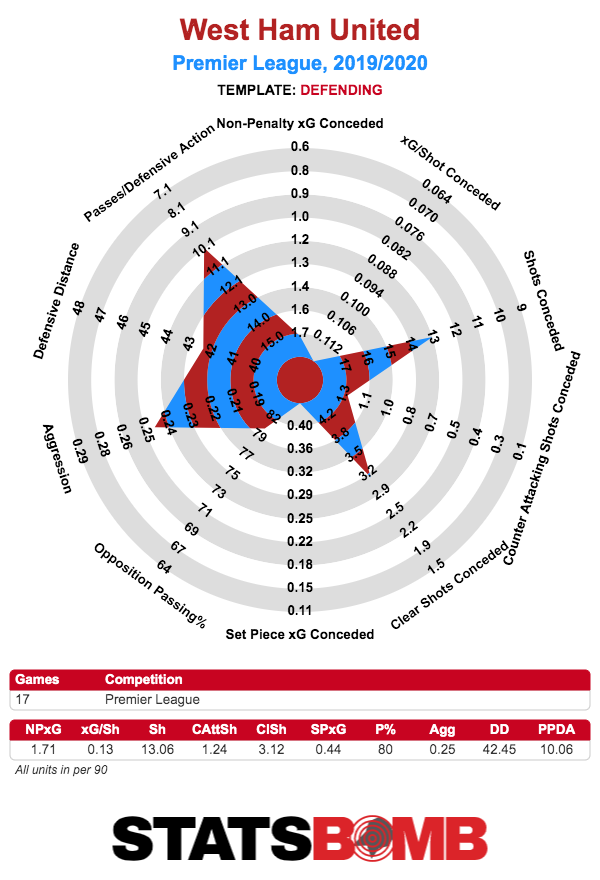 The curious thing is that the difference hasn’t really been down to good goalkeeping. On the post-shot model, West Ham’s xG conceded falls to 12.36. The biggest factor in this seems to be opposing players just outright missing the target on a few really good shots. It goes without saying that you do not want to be relying on your opposition to have bad finishing days to bail you out. This all gives us a side with the second worst xG difference in the league. It’s not exactly the recipe for challenging the top six.
The curious thing is that the difference hasn’t really been down to good goalkeeping. On the post-shot model, West Ham’s xG conceded falls to 12.36. The biggest factor in this seems to be opposing players just outright missing the target on a few really good shots. It goes without saying that you do not want to be relying on your opposition to have bad finishing days to bail you out. This all gives us a side with the second worst xG difference in the league. It’s not exactly the recipe for challenging the top six. 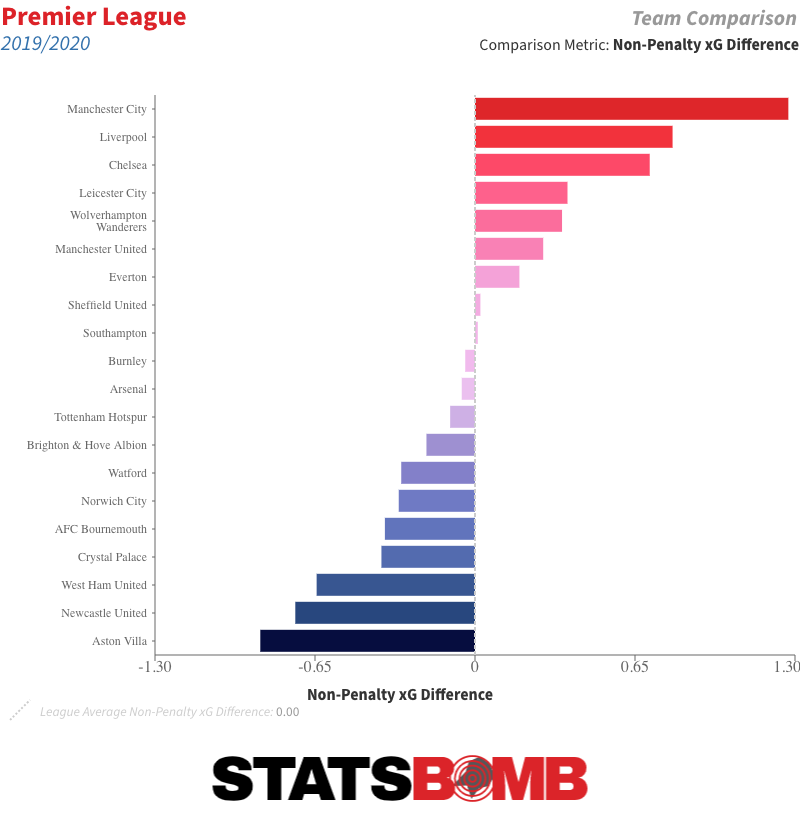 Defending, of course, starts from the front. In Haller, West Ham have a hard working forward, and behind him have been generally three of Felipe Anderson, Andriy Yarmolenko, Manuel Lanzini and Fornals. None of these players could be accused of laziness. All but Yarmolenko are at over 20 pressures per 90, and the Ukrainian still puts up a reasonable 15. But a high volume of pressures doesn’t necessarily equal an effective co-ordinated pressing effort. Despite such excellent pressing attackers, West Ham are still one of the deeper defending sides in the league, with the fifth lowest defensive distance. Whatever these forward players are doing in their hard work, the defensive activity map suggests that it doesn’t seem to be making life easier for those behind them.
Defending, of course, starts from the front. In Haller, West Ham have a hard working forward, and behind him have been generally three of Felipe Anderson, Andriy Yarmolenko, Manuel Lanzini and Fornals. None of these players could be accused of laziness. All but Yarmolenko are at over 20 pressures per 90, and the Ukrainian still puts up a reasonable 15. But a high volume of pressures doesn’t necessarily equal an effective co-ordinated pressing effort. Despite such excellent pressing attackers, West Ham are still one of the deeper defending sides in the league, with the fifth lowest defensive distance. Whatever these forward players are doing in their hard work, the defensive activity map suggests that it doesn’t seem to be making life easier for those behind them. 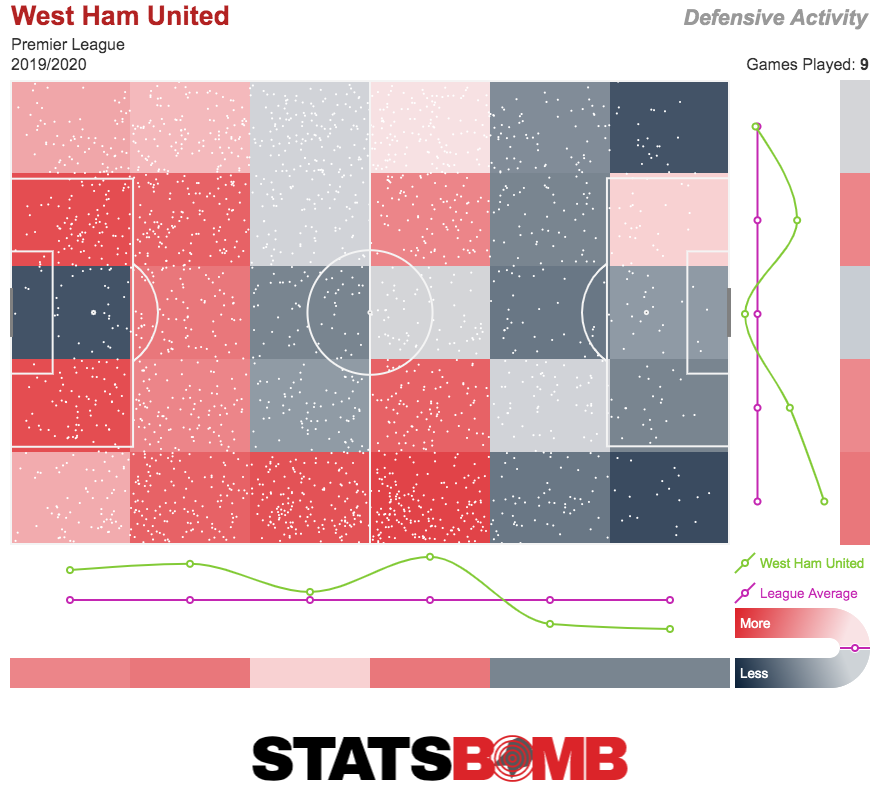 And behind them is the best midfield in the country, if the only aim of a midfield is to love the club and show loads of passion. Unfortunately, it isn’t. There are things to like about Declan Rice as a player. He recycles the ball well while being a reasonable contributor defensively, all at age 20. This suggests he’s well on the way to maturing into a very good midfielder. What he isn’t, and will likely never be, is a firefighter who can fix the defensive issues of a team, N’Golo Kanté style.
And behind them is the best midfield in the country, if the only aim of a midfield is to love the club and show loads of passion. Unfortunately, it isn’t. There are things to like about Declan Rice as a player. He recycles the ball well while being a reasonable contributor defensively, all at age 20. This suggests he’s well on the way to maturing into a very good midfielder. What he isn’t, and will likely never be, is a firefighter who can fix the defensive issues of a team, N’Golo Kanté style. 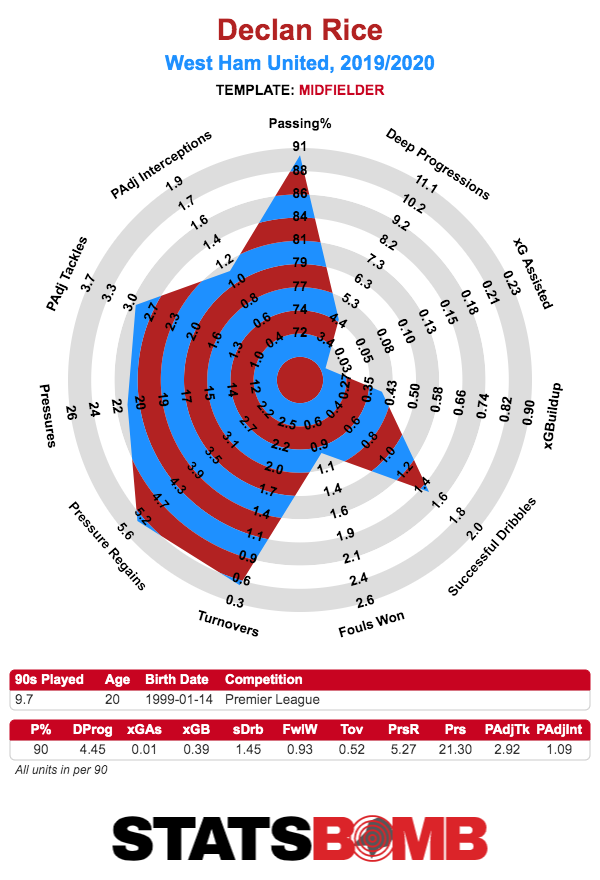 What he needs is a decent ball winner alongside him. With Jack Wilshere being the injury ravaged limited player he’s ended up being, Pellegrini has generally opted for Rice at the base of the midfield behind one of the more creative players and Mr. West Ham himself, Noble. However people may have felt about the Englishman in the past, it’s obvious that his best years are behind him. He’s still reasonable in possession, but he just doesn’t really win the ball back much at all. Rice is thus being asked to do a lot more work than he is capable of.
What he needs is a decent ball winner alongside him. With Jack Wilshere being the injury ravaged limited player he’s ended up being, Pellegrini has generally opted for Rice at the base of the midfield behind one of the more creative players and Mr. West Ham himself, Noble. However people may have felt about the Englishman in the past, it’s obvious that his best years are behind him. He’s still reasonable in possession, but he just doesn’t really win the ball back much at all. Rice is thus being asked to do a lot more work than he is capable of. 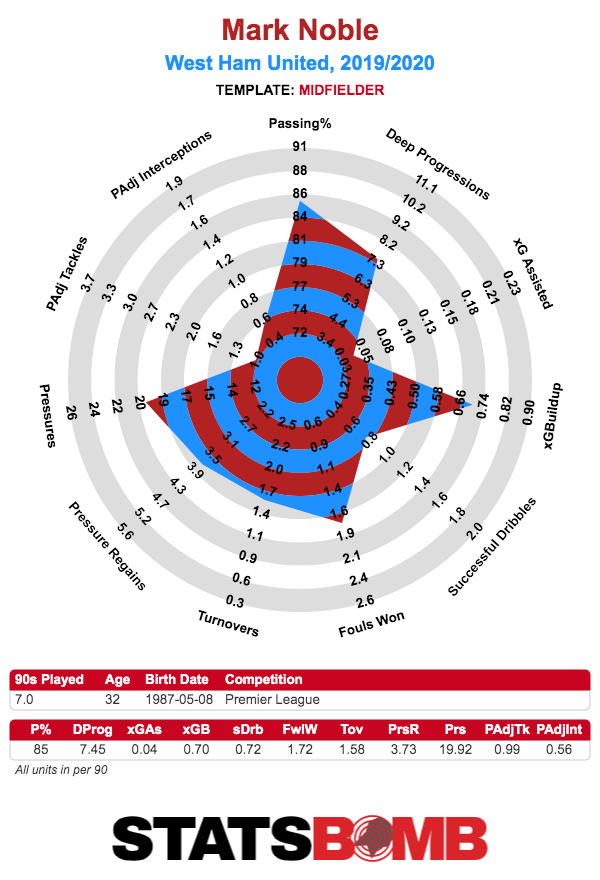 Ryan Fredericks has established himself as the regular right back and this is interesting because of how much he gets forward. As previously found, there aren’t many players in the Premier League attempting more passes inside the box than Fredericks. This is great if you want to be doing a lot of attacking through your fullbacks, but is that really how West Ham should be operating? On the other flank, Arthur Masuaku and Aaron Cresswell have been job sharing, and while both are adequate, neither could really call themselves the all conquering defender the system requires. As for the centre backs, Mark Thompson thinks they’re broadly fine, and no one publicly knows more about evaluating centre backs than him. But fine isn’t enough when the side is being battered like this. Despite a somewhat mediocre reputation in the UK, Pellegrini is certainly a talented coach. He’s someone who places a lot of emphasis on letting the talent of the attacking individuals shine, and it worked to great effect in La Liga, while working well enough to win a Premier League title at Manchester City. He’s assembled himself something of a budget version of that talent at the London Stadium, and that might be the problem. It’s one thing for a club like Manchester City to play Pellegrini’s very open, high variance football. The side with better players is inevitably favoured in those kinds of games, and City had more talent than almost anyone else. Meanwhile Vincent Kompany did an exemplary job of holding a mess of a defence together, along with Fernandinho’s defensive midfield qualities that only recently have become properly appreciated. At West Ham, he’s trying the same trick with not that much more than league average talent. They’re playing high variance football without being the dominant side that thrives in those situations. The effects are what one would expect them to be. Is this something that can be fixed? The most straightforward solution is to just buy a really good defensive midfielder in January. It should have been a priority in the summer, but let’s assume West Ham either cannot afford to splash out or just can’t find someone in the role they really like. Can this group of players play a more conservative style of football? Can Pellegrini coach something that isn’t all action, all the time? The balance is wrong right now. But would a more defensive move guarantee better results? It’s not obvious. But West Ham need to answer these questions very soon or things could start to get concerning. Header image courtesy of the Press Association
Ryan Fredericks has established himself as the regular right back and this is interesting because of how much he gets forward. As previously found, there aren’t many players in the Premier League attempting more passes inside the box than Fredericks. This is great if you want to be doing a lot of attacking through your fullbacks, but is that really how West Ham should be operating? On the other flank, Arthur Masuaku and Aaron Cresswell have been job sharing, and while both are adequate, neither could really call themselves the all conquering defender the system requires. As for the centre backs, Mark Thompson thinks they’re broadly fine, and no one publicly knows more about evaluating centre backs than him. But fine isn’t enough when the side is being battered like this. Despite a somewhat mediocre reputation in the UK, Pellegrini is certainly a talented coach. He’s someone who places a lot of emphasis on letting the talent of the attacking individuals shine, and it worked to great effect in La Liga, while working well enough to win a Premier League title at Manchester City. He’s assembled himself something of a budget version of that talent at the London Stadium, and that might be the problem. It’s one thing for a club like Manchester City to play Pellegrini’s very open, high variance football. The side with better players is inevitably favoured in those kinds of games, and City had more talent than almost anyone else. Meanwhile Vincent Kompany did an exemplary job of holding a mess of a defence together, along with Fernandinho’s defensive midfield qualities that only recently have become properly appreciated. At West Ham, he’s trying the same trick with not that much more than league average talent. They’re playing high variance football without being the dominant side that thrives in those situations. The effects are what one would expect them to be. Is this something that can be fixed? The most straightforward solution is to just buy a really good defensive midfielder in January. It should have been a priority in the summer, but let’s assume West Ham either cannot afford to splash out or just can’t find someone in the role they really like. Can this group of players play a more conservative style of football? Can Pellegrini coach something that isn’t all action, all the time? The balance is wrong right now. But would a more defensive move guarantee better results? It’s not obvious. But West Ham need to answer these questions very soon or things could start to get concerning. Header image courtesy of the Press Association
2019
West Ham Aren’t Getting the Balance Right
By admin
|
October 23, 2019
